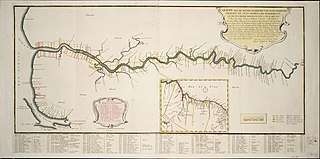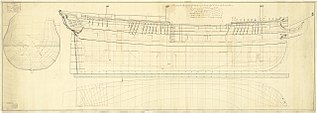
The Fourth Anglo-Dutch War was a conflict between the Kingdom of Great Britain and the Dutch Republic. The war, contemporary with the War of American Independence (1775–1783), broke out over British and Dutch disagreements on the legality and conduct of Dutch trade with Britain's enemies in that war.

Demerara is a historical region in the Guianas, on the north coast of South America, now part of the country of Guyana. It was a colony of the Dutch West India Company between 1745 and 1792 and a colony of the Dutch state from 1792 until 1815. It was merged with Essequibo in 1812 by the British who took control. It formally became a British colony in 1815 until Demerara-Essequibo was merged with Berbice to form the colony of British Guiana in 1831. In 1838, it became a county of British Guiana until 1958. In 1966, British Guiana gained independence as Guyana and in 1970 it became a republic as the Co-operative Republic of Guyana. It was located around the lower course of the Demerara River, and its main settlement was Georgetown.

Armand-Guy-Simon de Coetnempren, comte de Kersaint, in short Armand de Kersaint, was a French sailor and politician. A Girondin, Kersaint held important naval posts during the early stages of the French Revolution.

Berbice is a region along the Berbice River in Guyana, which was between 1627 and 1792 a colony of the Dutch West India Company and between 1792 and 1815 a colony of the Dutch state. After having been ceded to the United Kingdom of Great Britain and Ireland in the latter year, it was merged with Demerara-Essequibo to form the colony of British Guiana in 1831. It became a county of British Guiana in 1838 till 1958. In 1966, British Guiana gained independence as Guyana and in 1970 it became a republic as the Co-operative Republic of Guyana.

Essequibo was a Dutch colony in the Guianas and later a county on the Essequibo River in the Guiana region on the north coast of South America. It was a colony of the Dutch West India Company between 1616 and 1792 and a colony of the Dutch state from 1792 until 1815. It was merged with Demerara in 1812 by the British who took control. It formally became a British colony in 1815 until Demerara-Essequibo was merged with Berbice to form the colony of British Guiana in 1831. In 1838, it became a county of British Guiana till 1958. In 1966, British Guiana gained independence as Guyana and in 1970 it became a republic as the Co-operative Republic of Guyana. It was located around the lower course of the Essequibo River.

Fort Zeelandia is located on Fort Island, a fluvial island of the Essequibo River delta in the Essequibo Islands-West Demerara region of Guyana. Not to be confused with Fort Zeelandia in Paramaribo, Suriname, the current brick fort was built in 1743 for the Essequibo colony, replacing an earlier wooden fort built in 1726, and is among the oldest structures in Guyana. The fort replaced Fort Kyk-Over-Al as the capital of Essequibo in 1739.

Iphigénie was a 32-gun Iphigénie-class frigate of the French Navy, and the lead ship of her class. She was briefly in British hands after the Anglo-Spanish capture of Toulon in August 1793 but the French recaptured her December. The Spanish captured her in 1795 and her subsequent fate is unknown.

On 18 February 1797, a fleet of 18 British warships under the command of Sir Ralph Abercromby invaded and took the Island of Trinidad. Within a few days the last Spanish Governor, Don José María Chacón surrendered the island to Abercromby.

The Dutch West Indies campaign was a series of minor conflicts in 1781 and 1782, in the Fourth Anglo-Dutch War and the American Revolutionary War. Following Great Britain's declaration of war on the Dutch Republic in December 1780, British Admiral George Brydges Rodney, the commander of the Royal Navy in the West Indies, was notified by a fast-sailing packet ship of the declaration. He immediately acted to ensure control over as many of the Dutch colonies as possible, capturing Sint Eustatius, a vital entrepot of French and Dutch trade between their colonies and Europe, in early February 1781. He also captured Saba and Sint Maarten, and orchestrated the capture of the Dutch colonial outposts of Berbice, Demerara, and Essequibo in South America. A planned expedition by Samuel Hood against Curaçao was called off on rumors that a French fleet was approaching. A French expedition in 1782 captured Demerara and Essequibo, although the fate of the other colonies were settled at the conclusion of the war.

The Caribbean campaign of 1803–1810 was a series of military contests mainly in the West Indies spanning the Napoleonic Wars involving European powers Napoleonic France, the Batavian Republic, Spain, the Kingdom of Portugal and the United Kingdom of Great Britain and Ireland. Eventually British naval forces dominated the seas and by 1810 every French, Dutch and Danish colony was firmly under allied control.

The Capture of Sint Eustatius took place in February 1781 during the Fourth Anglo-Dutch War when British army and naval forces under Lieutenant-General Sir John Vaughan and Admiral George Rodney seized the Dutch-owned Caribbean island of Sint Eustatius. The capture was controversial in Britain, as it was alleged that Vaughan and Rodney had used the opportunity to enrich themselves and had neglected more important military duties. The island was subsequently taken by Dutch-allied French forces in late 1781, ending the British occupation.
Orénoque by one account was a French privateer sloop commissioned in French Guiana in 1781. Another account has her as a Dutch merchant vessel purchased into service. If so, she may have been one of the vessels that some British privateers captured during the raid on Essquinbo and Demerara in late February 1781. The French captured her in 1782 when they captured Demerara; they disposed of her in 1784 or so.
The raid on Demerara and Essequibo took place between 24 and 27 February 1781 in the context of the Fourth Anglo-Dutch War (1780–1784). Six British privateers entered the rivers and captured 15 Dutch vessels before withdrawing.
Bunker Hill was a Massachusetts privateer sloop, first commissioned in 1778. She made two cruises, capturing three prizes, but during her second cruise the Royal Navy captured her at Saint Lucia. The Royal Navy took her into service as HMS Surprize. She served in the Caribbean, and was one of the two sloops that captured Essequibo and Demerara in March 1781. She sailed to Britain in late 1782 where the Navy sold her in 1783. The French Navy may have purchased her. If so, they sold her in 1789.

HMS Barbuda was commissioned into the Royal Navy in 1780 after having briefly served as an American privateer. Barbuda was one of the two sloops that captured Demerara and Essequibo in 1781, but the French Navy captured her there in 1782 and took her into service as Barboude. The French Navy sold her to private owners in 1786, and she served briefly as a privateer in early 1793 before the French Navy purchased her again and named her Légère. She served them until mid-1796 when the Royal Navy captured her and took her into service as HMS Legere. She was wrecked off the coast of Colombia, without loss of life, in February 1801.
HMS Stormont was the highly successful American privateer General Pickering, which Admiral Rodney's British fleet captured on 3 February 1781 at the capture of Sint Eustatius. She was one of nine captured American vessels that the British sent to Antigua a few days later to be assessed for possible purchase. The Royal Navy purchased General Pickering on 14 February and Commander Nicholas Charrington commissioned her in the Leeward Islands for service as HM Sloop Stormont. Commander Christmas Paul replaced Charrington.
Antony Beaujon also Anthony was a Dutch and British civil servant and politician in Guyana. He served as Governor of Demarara from May 1795 until 5 July 1802, and as Lieutenant governor of Demerara and Essequibo from 13 August 1804 until his death.

HMS Chichester was a two-deck, fifth-rate ship of the Royal Navy. One of the Adventure-class ships designed by Edward Hunt, she was built to carry 44 guns but for her entire career she served as a troopship, never carrying more than 22. In 1803, she was part of the squadron under Samuel Hood that captured the French held islands of St Lucia and Tobago, and the Dutch colonies of Demerara, Essequibo and Berbice.
The York Light Infantry Volunteers, also known as the Barbados Volunteer Emigrants, was a foreign light infantry regiment of the British Army during the Napoleonic Wars. It was formed in September 1803 from the Dutch garrisons of the captured Batavian colonies of Demerara, Essequibo, and Berbice. Additions to the regiment were recruited from the ranks of prisoners of war, and the regiment was also the recipient of the majority of deserters taken in the Peninsular Wars. The regiment served its whole existence in the West Indies, fighting in the British West Indies campaign. It was present at the Battle of Suriname in 1804 and at the invasions of Martinique and Guadeloupe in 1809 and 1810 respectively. It finished the Napoleonic Wars as garrison at Jamaica, before in early 1817 being sent to England, where it was disbanded on 19 March.
The British campaign in the Caribbean took place during the first year of the Napoleonic Wars and began shortly after the breakdown of the Treaty of Amiens. Hostilities with France resumed in May 1803 but official notification did not arrive in the West Indies until mid-June, along with British orders to attack France's valuable sugar islands. The expedition, under commanders in chief William Grinfield and Samuel Hood, set out from Barbados on 20 June with 3,149 soldiers, two ships-of-the-line, two frigates, converted to troopships, and two sloops. St Lucia was captured on 22 June 1803, after the island's main fortress, Morne Fortunee had been stormed, and Tobago nine days later. After leaving men to hold these islands, the expedition returned to Barbados.












